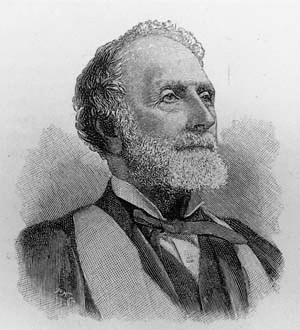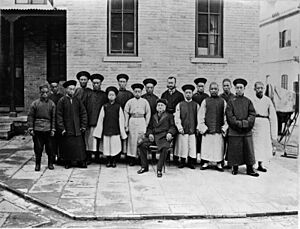Thomas Francis Wade facts for kids
Quick facts for kids
Thomas Francis Wade
|
|||||||||
|---|---|---|---|---|---|---|---|---|---|

Thomas Wade (published 1895)
|
|||||||||
| Born | 25 August 1818 London, England
|
||||||||
| Died | 31 July 1895 (aged 76) Cambridge, England
|
||||||||
| Alma mater | Trinity College, Cambridge | ||||||||
| Scientific career | |||||||||
| Fields | Sinology | ||||||||
| Chinese name | |||||||||
| Traditional Chinese | 威妥瑪 | ||||||||
| Simplified Chinese | 威妥玛 | ||||||||
|
|||||||||
Sir Thomas Francis Wade (25 August 1818 – 31 July 1895) was a British diplomat and expert on China. He created an early textbook for learning Chinese in English in 1867. This book later became the basis for the Wade-Giles system. This system helps people write Mandarin Chinese words using the English alphabet. Herbert Giles improved it in 1892. Sir Thomas Wade was also the first professor of Chinese at Cambridge University.
Contents
Early Life and Education
Thomas Wade was born in London, England. His father was Colonel Thomas Wade. Young Thomas went to school at Harrow and then to Trinity College, Cambridge.
In 1838, he joined the army. He served with his regiment in the Ionian Islands. During this time, he spent his free time studying Italian and modern Greek.
Working in China
In 1841, Thomas Wade became a lieutenant. He was sent to China and arrived in Hong Kong in June 1842. At this time, the First Opium War was happening near the Yangtze River. Wade and his regiment took part in battles there.
In 1843, he became a Cantonese interpreter for the army in Hong Kong. Two years later, he worked for the Supreme Court of Hong Kong. In 1846, he became an assistant Chinese secretary.
In 1852, he became a vice-consul in Shanghai. The city's government was having problems because of the Taiping Rebellion. So, a group of three people, including Wade, were put in charge of collecting customs duties from foreign ships. This was the start of the Imperial Maritime Customs Service.
Important Diplomatic Roles
In 1855, Wade became the Chinese secretary to Sir John Bowring in Hong Kong. When the Second Opium War began in 1857, he worked with Lord Elgin. Wade helped with talks that led to the Treaty of Tientsin in 1858.
The next year, he went with Sir Frederick Bruce to exchange the treaty. He was present at Taku when British forces were attacked.
When Lord Elgin returned to China in 1860, Wade continued as Chinese secretary. He helped arrange for British and French forces to advance to Tientsin and then towards Peking (now Beijing). Wade played a key role in these talks. When the British embassy was set up in Peking, he became the Chinese secretary there. In 1862, Wade received an honour called Companion of the Bath.
Wade was in charge of the British embassy in Peking for several periods. From 1871, he was the main British representative in China until he retired in 1883. He handled difficult talks after the 1870 Tientsin Massacre. He was knighted in 1875. Wade also negotiated the Chefoo Convention in 1876 with Li Hongzhang. He then received another honour, KCB.
Return to England
After working in China for over forty years, Sir Thomas Wade returned to England in 1883. Three years later, he gave 4,304 Chinese books to the Cambridge University Library.
In 1888, he became the first Professor of Chinese at the University of Cambridge. He held this job until he passed away in Cambridge at age 77. He also served as president of the Royal Asiatic Society from 1887 to 1890.
Wade was married to Amelia Herschel. She was the daughter of the famous astronomer John Herschel.
Published Works
Besides his diplomatic work, Wade wrote books to help people learn the Chinese language.
- The Peking Syllabary (Hong Kong), 1859. This book helped people learn the sounds of the Beijing dialect.
- Yü-yen Tzŭ-erh Chi (London, 1867). This was a course to help students learn spoken Chinese.
- ῾Han Tzŭ Hsi Hsieh Fa (London, 1867). These were writing exercises to go with his spoken Chinese course.
- Wên-chien Tzŭ-erh Chi (London, 1867). This book had examples of Chinese documents.
In these books, Wade created a new way to write Chinese sounds using the Latin alphabet. This is called "romanization." His system was based on how people spoke in Beijing. Later, Herbert Giles changed Wade's system a bit. This improved system became known as Wade-Giles. It was the main way to write Chinese in English for much of the 20th century. Even though the Pinyin system is now more common, Wade-Giles is still used in some places.


